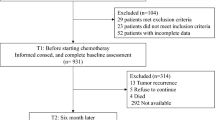Abstract
A self-report questionnaire module consisting of 24 items, comprising 5 scales and 7 single items, has been developed for measuring health-related quality of life in patients with brain cancer. Module development proceeded through several stages, including a listing of patient, family and health care professional concerns, the writing of items, field testing in 105 patients with brain cancer and subsequent item reduction and scale construction after multitrait scaling analysis and assessment of internal consistency (Cronbach's coefficient α). The final version of the module exhibits reasonable test-retest stability over a period of one week. Differences in the responses between patients with recently-diagnosed and recurrent cancer and between patients with a Karnofsky Performance Score (KPS) of 50–70 and 80–100 were in the expected direction, indicating that the module of questions is responsive to differing conditions. Patients with either mental confusion, motor deficit or dysphasia indicated problems in several domains and single items as compared to patients without these neurological deficits. Thus, differences in the responses to the items in the brain cancer module appear to reflect differences in neurological status. In adclition, deteriorating neurological status was accompanied by a marked increase in emotional distress, future uncertainty and motor dysfunction. A comparison of the responses in the module with the KPS and with a modified Barthel Activities of Daily Living Index (BADLI) shows moderate correlations, primarily with scales and items that pertain to motor dysfunction, while other scales (such as emotional distress, visual disorder and communication deficit) and most single items are not associated with the KPS or BADLI. Since the emotional distress scale of the module was found to be highly correlated with the emotional function scale of the EORTC QLQ-C30, it could be omitted when the module is used in combination with the QLQ-C30. This would reduce the module to a total of 20 items with four scales and seven single items. The intention is to combine this module of questions with other core or general quality-of-life questionnaires when studying patients with brain cancer in clinical trials.
Similar content being viewed by others
References
Mackworth N, Fobair P, Prados MD. Quality of life self-reports from 200 brain tumor patients: comparisons with Karnofsky performance scores. J Neuro-Oncol 1992; 14: 243–253.
Aaronson NK, Ahmedzai S, Bergman B, et al. The European Organization for Research and Treatment of Cancer QLQ-C30: A quality-of-life instrument for use in international trials in oncology. J Natl Cancer Inst 1993; 85: 365–76.
Grant R, Slattery J, Gregor A, et al. Recording neurological impairment in clinical trials of glioma. J Neuro-Oncol 1994; 19: 37–49.
Taphoorn MJB, Heinmans JJ, Snoek FJ, et al. Assessment of quality of life in patients treated for low-grade glioma: A preliminary report. J Neurol Neurosurg Psychiat 1992; 55: 372–376.
Sachsenheimer W, Piotrowski W, Bimmler T. Quality of life in patients with intracranial tumors on the basis of Karnofsky's performance status. J Neuro-Oncol 1992; 13: 177–181.
Archibald YM, Lunn D, Ruttan LA, et al. Cognitive functioning in long-term survivors of high-grade glioma. J Neurosurg 1994; 80: 247–253.
Aaronson NK, Bullinger M, Ahmedzai SA. A modular approach to quality-of-life assessment in cancer clinical trials. Rec Results in Cancer Res 1988; 111: 231–247.
Osoba D. Self-rating symptom checklists: a simple method for recording and evaluating symptom control in oncology. Cancer Treat Rev 1993; 19(Suppl A): 43–51.
Sprangers MAG, Cull A, Bjordal K et al. The European Organization for Research and Treatment of Cancer approach to quality of life assessment: guidelines for developing questionnaire modules. Qual Life Res 1993; 2: 287–295.
Osoba D. The Quality of Life Committee of the Clinical Trials Group of the National Institute of Canada: organization and functions. Qual Life Res 1992; 1: 211–218.
Karnofsky DA, Abelman WH, Craves LF et al. The use of nitrogen mustards in palliative treatment of carcinoma. Cancer 1948; 1: 634–656.
McDowell I, Newell C. Measuring Health: A Guide to Rating Scales and Questionnaires. The Barthel Index Oxford: Oxford University Press, 1987: 49–54.
Hays RD, Hayashi T, Carson S, et al. User's guide for the Multitrait Analysis Program (MAP). Santa Monica, CA: Rand Corporation, 1988.
Cronbach LJ. Coefficient alpha and the internal structure of tests. Psychometrika, 1951; 16: 297–334.
Steel RGD, Torrie JH, Principles and Procedures of Statistics, 2nd ed. New York: McGraw-Hill, 1960.
Author information
Authors and Affiliations
Corresponding author
Additional information
M.-A. Hsu is currently with Pfizer, New York, NY, USA.
Rights and permissions
About this article
Cite this article
Osoba, D., Aaronson, N.K., Muller, M. et al. The development and psychometric validation of a brain cancer quality-of-life questionnaire for use in combination with general cancer-specific questionnaires. Qual Life Res 5, 139–150 (1996). https://doi.org/10.1007/BF00435979
Received:
Accepted:
Issue Date:
DOI: https://doi.org/10.1007/BF00435979




